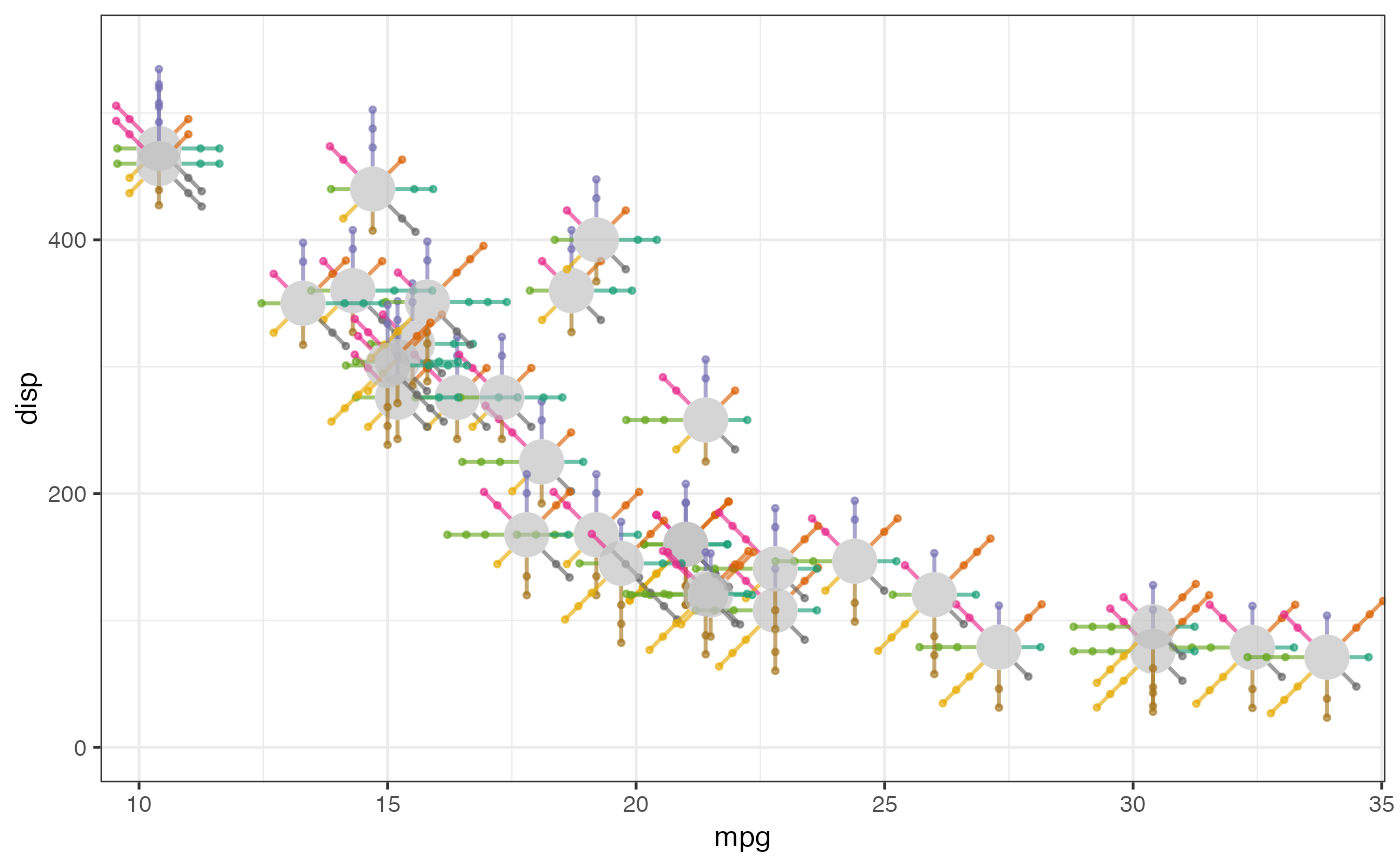The metroglyph geom is used to plot multivariate data as metroglyphs (Anderson 1957; duToit et al. 1986) in a scatterplot.
Usage
geom_metroglyph(
mapping = NULL,
data = NULL,
stat = "identity",
position = "identity",
...,
cols = character(0L),
circle.size = 1,
colour.circle = NULL,
colour.ray = NULL,
colour.points = NULL,
linewidth.circle = 1,
linewidth.ray = 1,
lineend = "butt",
full = TRUE,
draw.grid = FALSE,
grid.point.size = 1,
show.legend = NA,
repel = FALSE,
repel.control = gglyph.repel.control(),
inherit.aes = TRUE
)Arguments
- mapping
Set of aesthetic mappings created by
aes()oraes_(). If specified andinherit.aes = TRUE(the default), it is combined with the default mapping at the top level of the plot. You must supplymappingif there is no plot mapping.- data
The data to be displayed in this layer. There are three options:
If
NULL, the default, the data is inherited from the plot data as specified in the call toggplot().A
data.frame, or other object, will override the plot data. All objects will be fortified to produce a data frame. Seefortify()for which variables will be created.A
functionwill be called with a single argument, the plot data. The return value must be adata.frame, and will be used as the layer data. Afunctioncan be created from aformula(e.g.~ head(.x, 10)).- stat
The statistical transformation to use on the data for this layer, as a string.
- position
Position adjustment, either as a string, or the result of a call to a position adjustment function.
- ...
Other arguments passed on to
layer(). These are often aesthetics, used to set an aesthetic to a fixed value, likecolour = "green"orsize = 3. They may also be parameters to the paired geom/stat.- cols
Name of columns specifying the variables to be plotted in the glyphs as a character vector.
- circle.size
The size of the central circle (radius).
- colour.circle
The colour of circles.
- colour.ray
The colour of rays.
- colour.points
The colour of grid points.
- linewidth.circle
The circle line width.
- linewidth.ray
The ray line width.
- lineend
The line end style for the rays. Either
"round","butt"or"square".- full
logical. If
TRUE, full star glyphs (360°) are plotted, otherwise half star glyphs (180°) are plotted.- draw.grid
logical. If
TRUE, grid points are plotted along the whiskers if all the variables specified incolsare of type factor. Default isFALSE.- grid.point.size
The size of the grid points in native units.
- show.legend
logical. Should this layer be included in the legends?
NA, the default, includes if any aesthetics are mapped.FALSEnever includes, andTRUEalways includes. It can also be a named logical vector to finely select the aesthetics to display.- repel
logical. If
TRUE, the glyphs are repel away from each other to avoid overlaps. Default isFALSE.- repel.control
A list of control settings for the repel algorithm. Ignored if
repel = FALSE. Seegglyph.repel.controlfor details on the various control parameters.- inherit.aes
If
FALSE, overrides the default aesthetics, rather than combining with them. This is most useful for helper functions that define both data and aesthetics and shouldn't inherit behaviour from the default plot specification, e.g.borders().
Aesthetics
geom_metroglyph() understands the following
aesthetics (required aesthetics are in bold):
x
y
alpha
colour
fill
group
circle.size
See vignette("ggplot2-specs", package = "ggplot2") for further
details on setting these aesthetics.
The following additional aesthetics are considered if repel = TRUE:
point.size
segment.linetype
segment.colour
segment.size
segment.alpha
segment.curvature
segment.angle
segment.ncp
segment.shape
segment.square
segment.squareShape
segment.inflect
segment.debug
See ggrepel
examples page
for further details on setting these aesthetics.
References
Anderson E (1957).
“A semigraphical method for the analysis of complex problems.”
Proceedings of the National Academy of Sciences of the United States of America, 43(10), 923.
duToit SHC, Steyn AGW, Stumpf RH (1986).
Graphical Exploratory Data Analysis, Springer Texts in Statistics.
Springer-Verlag, New York.
ISBN 978-1-4612-9371-2.
See also
Other geoms:
geom_dotglyph(),
geom_pieglyph(),
geom_profileglyph(),
geom_starglyph(),
geom_tileglyph()
Examples
# Scale the data
zs <- c("hp", "drat", "wt", "qsec", "vs", "am", "gear", "carb")
mtcars[ , zs] <- lapply(mtcars[ , zs], scales::rescale)
mtcars$cyl <- as.factor(mtcars$cyl)
mtcars$lab <- row.names(mtcars)
library(ggplot2)
theme_set(theme_bw())
options(ggplot2.discrete.colour = RColorBrewer::brewer.pal(8, "Dark2"))
options(ggplot2.discrete.fill = RColorBrewer::brewer.pal(8, "Dark2"))
# Mapped colour
ggplot(data = mtcars) +
geom_metroglyph(aes(x = mpg, y = disp, colour = cyl),
cols = zs, circle.size = 3, colour.ray = NULL,
linewidth.circle = 2, linewidth.ray = 2,
size = 10, alpha = 0.8) +
ylim(c(-0, 550))
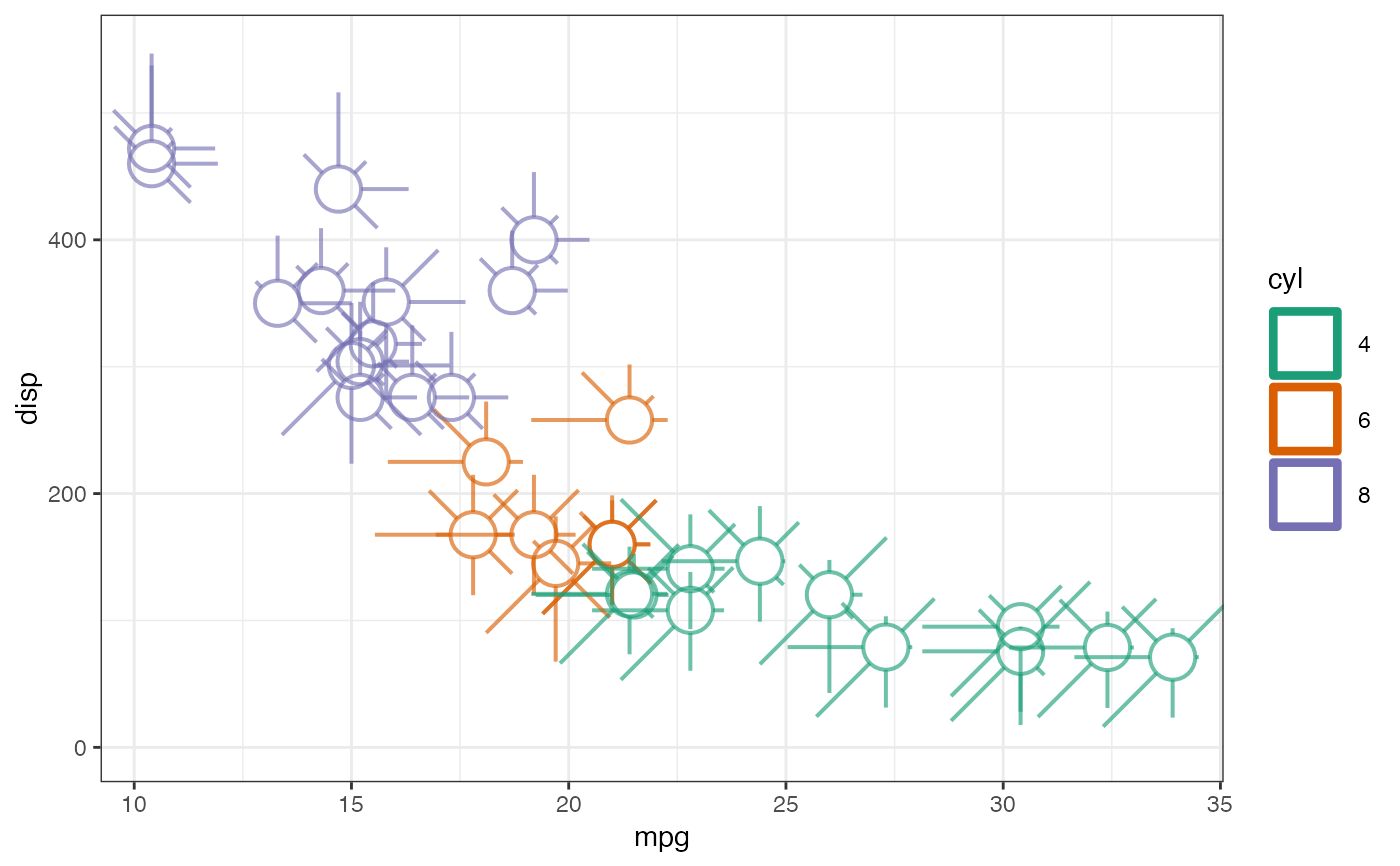 ggplot(data = mtcars) +
geom_metroglyph(aes(x = mpg, y = disp, colour = cyl),
cols = zs, circle.size = 3, colour.ray = NULL,
linewidth.circle = 2, linewidth.ray = 2, fill = "gray30",
size = 10, alpha = 0.8) +
ylim(c(-0, 550))
ggplot(data = mtcars) +
geom_metroglyph(aes(x = mpg, y = disp, colour = cyl),
cols = zs, circle.size = 3, colour.ray = NULL,
linewidth.circle = 2, linewidth.ray = 2, fill = "gray30",
size = 10, alpha = 0.8) +
ylim(c(-0, 550))
 ggplot(data = mtcars) +
geom_metroglyph(aes(x = mpg, y = disp, colour = cyl),
cols = zs, circle.size = 3, colour.ray = NULL,
linewidth.circle = 2, linewidth.ray = 2,
full = FALSE,
size = 10, alpha = 0.8) +
ylim(c(-0, 550))
ggplot(data = mtcars) +
geom_metroglyph(aes(x = mpg, y = disp, colour = cyl),
cols = zs, circle.size = 3, colour.ray = NULL,
linewidth.circle = 2, linewidth.ray = 2,
full = FALSE,
size = 10, alpha = 0.8) +
ylim(c(-0, 550))
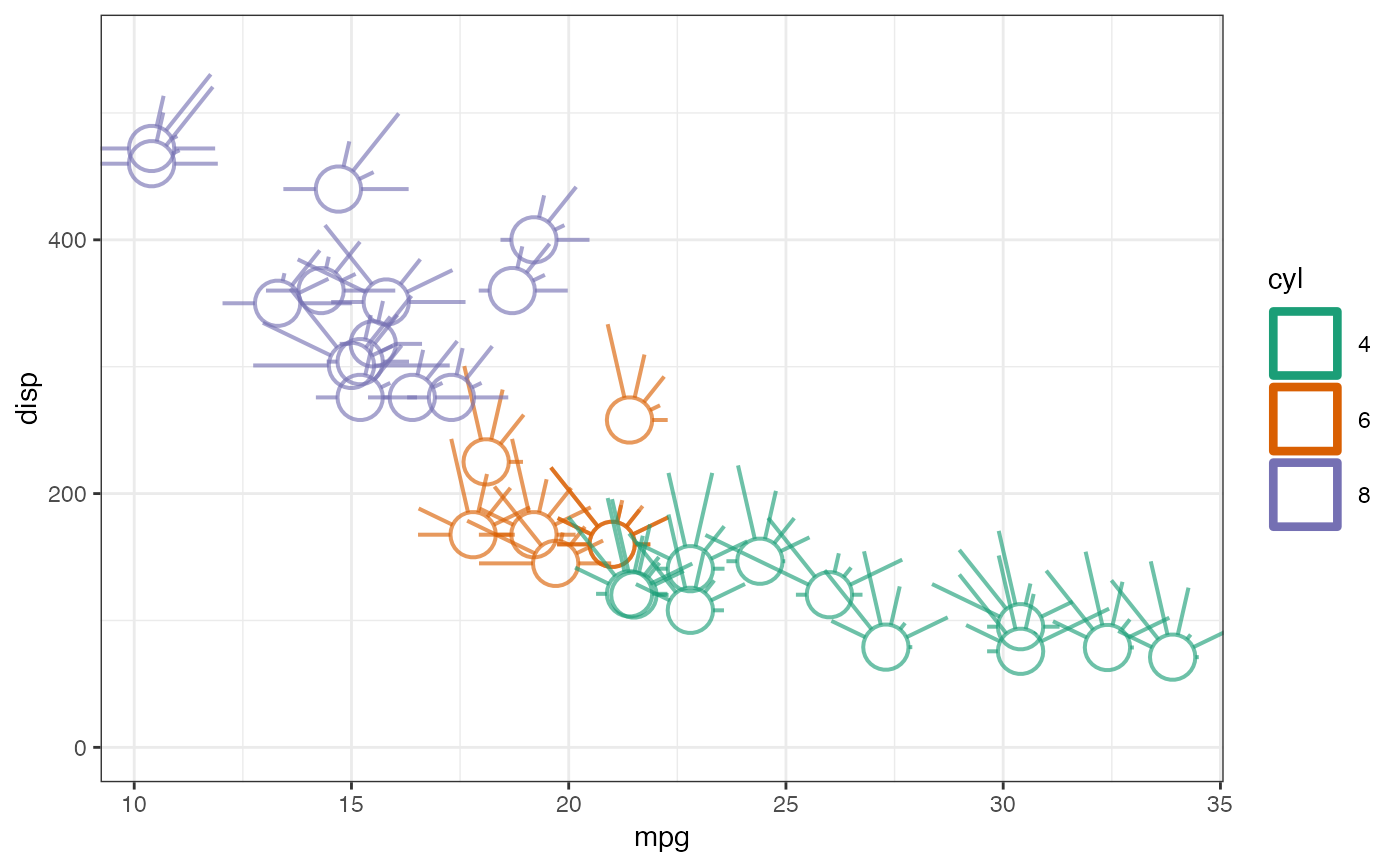 ggplot(data = mtcars) +
geom_metroglyph(aes(x = mpg, y = disp, colour = cyl),
cols = zs, circle.size = 3, colour.ray = NULL,
full = FALSE,
linewidth.circle = 2, linewidth.ray = 2, fill = "gray30",
size = 10, alpha = 0.8) +
ylim(c(-0, 550))
ggplot(data = mtcars) +
geom_metroglyph(aes(x = mpg, y = disp, colour = cyl),
cols = zs, circle.size = 3, colour.ray = NULL,
full = FALSE,
linewidth.circle = 2, linewidth.ray = 2, fill = "gray30",
size = 10, alpha = 0.8) +
ylim(c(-0, 550))
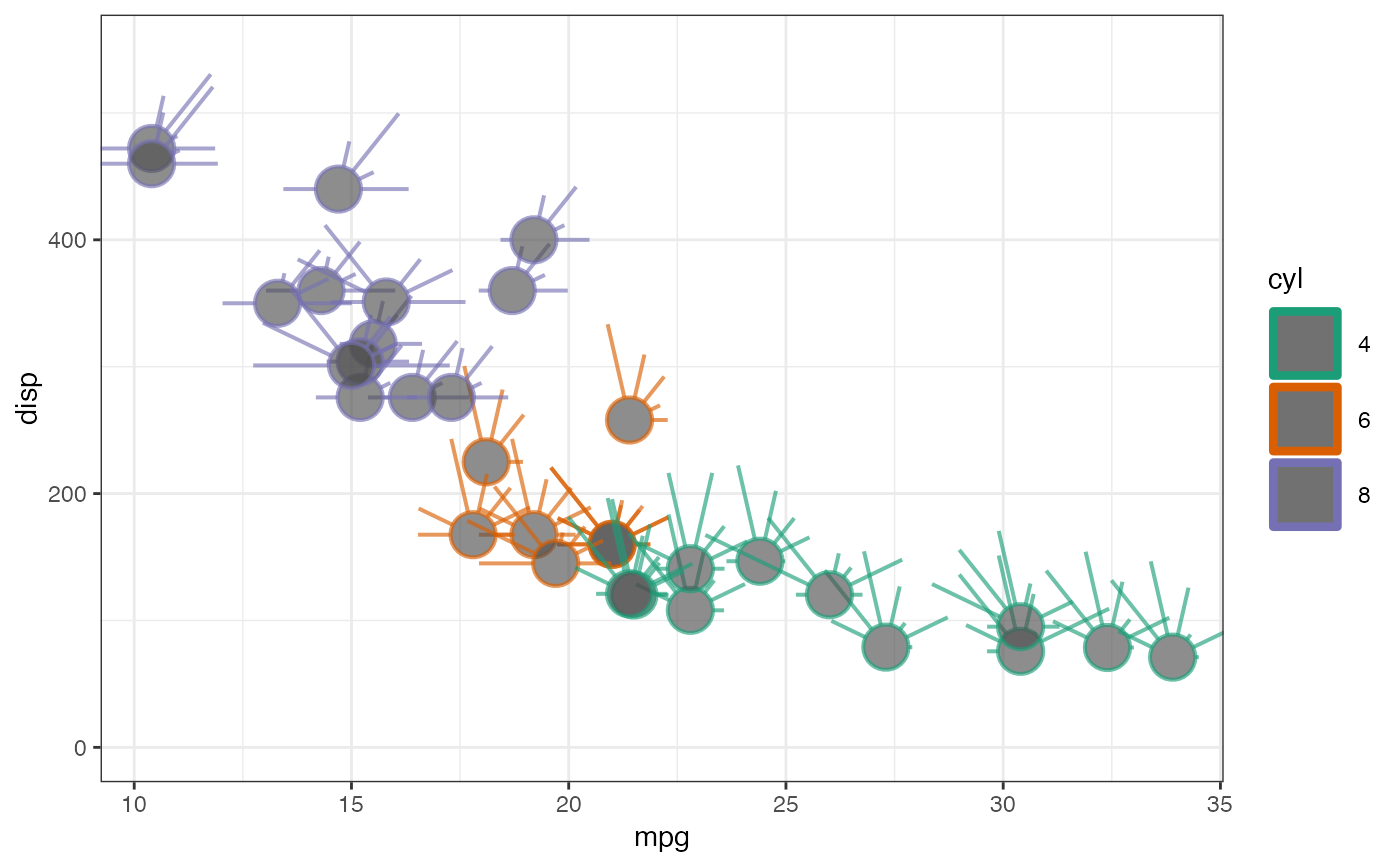 # Mapped colour + fill
ggplot(data = mtcars) +
geom_metroglyph(aes(x = mpg, y = disp, colour = cyl, fill = cyl),
cols = zs, circle.size = 3, colour.ray = NULL,
linewidth.circle = 2, linewidth.ray = 2,
size = 10, alpha = 0.8) +
ylim(c(-0, 550))
# Mapped colour + fill
ggplot(data = mtcars) +
geom_metroglyph(aes(x = mpg, y = disp, colour = cyl, fill = cyl),
cols = zs, circle.size = 3, colour.ray = NULL,
linewidth.circle = 2, linewidth.ray = 2,
size = 10, alpha = 0.8) +
ylim(c(-0, 550))
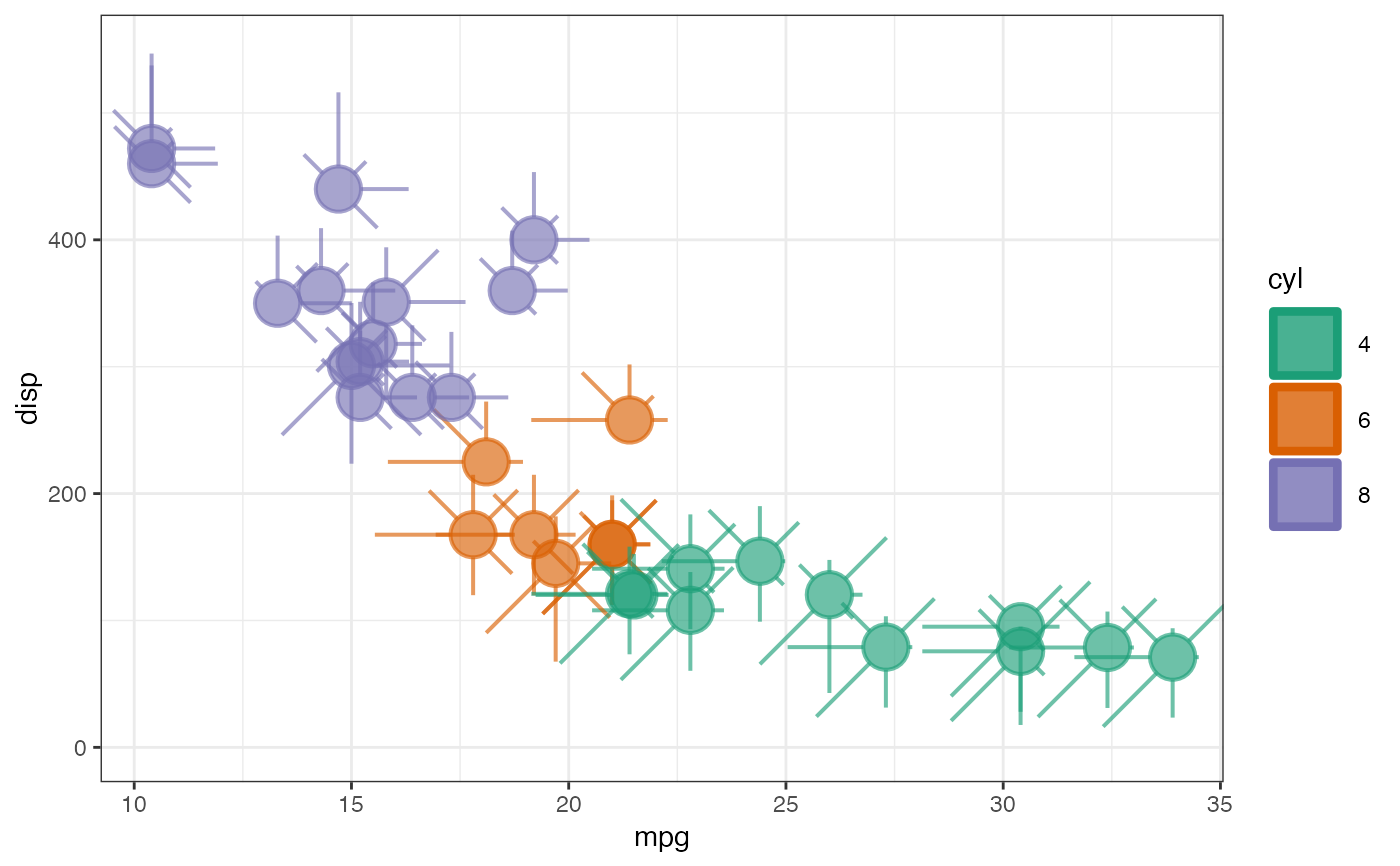 ggplot(data = mtcars) +
geom_metroglyph(aes(x = mpg, y = disp, colour = cyl, fill = cyl),
cols = zs, circle.size = 3, colour.ray = NULL,
full = FALSE,
linewidth.circle = 2, linewidth.ray = 2,
size = 10, alpha = 0.8) +
ylim(c(-0, 550))
ggplot(data = mtcars) +
geom_metroglyph(aes(x = mpg, y = disp, colour = cyl, fill = cyl),
cols = zs, circle.size = 3, colour.ray = NULL,
full = FALSE,
linewidth.circle = 2, linewidth.ray = 2,
size = 10, alpha = 0.8) +
ylim(c(-0, 550))
 # Mapped fill
ggplot(data = mtcars) +
geom_metroglyph(aes(x = mpg, y = disp, fill = cyl),
cols = zs, circle.size = 3, colour.ray = NULL,
linewidth.circle = 2, linewidth.ray = 2,
size = 10, alpha = 0.8) +
ylim(c(-0, 550))
# Mapped fill
ggplot(data = mtcars) +
geom_metroglyph(aes(x = mpg, y = disp, fill = cyl),
cols = zs, circle.size = 3, colour.ray = NULL,
linewidth.circle = 2, linewidth.ray = 2,
size = 10, alpha = 0.8) +
ylim(c(-0, 550))
 ggplot(data = mtcars) +
geom_metroglyph(aes(x = mpg, y = disp, fill = cyl),
cols = zs, circle.size = 3, colour.ray = NULL,
linewidth.circle = 2, linewidth.ray = 2,
colour.circle = "transparent",
size = 10, alpha = 0.8) +
ylim(c(-0, 550))
ggplot(data = mtcars) +
geom_metroglyph(aes(x = mpg, y = disp, fill = cyl),
cols = zs, circle.size = 3, colour.ray = NULL,
linewidth.circle = 2, linewidth.ray = 2,
colour.circle = "transparent",
size = 10, alpha = 0.8) +
ylim(c(-0, 550))
 ggplot(data = mtcars) +
geom_metroglyph(aes(x = mpg, y = disp, fill = cyl),
cols = zs, circle.size = 3, colour.ray = NULL,
full = FALSE,
linewidth.circle = 2, linewidth.ray = 2,
size = 10, alpha = 0.8) +
ylim(c(-0, 550))
ggplot(data = mtcars) +
geom_metroglyph(aes(x = mpg, y = disp, fill = cyl),
cols = zs, circle.size = 3, colour.ray = NULL,
full = FALSE,
linewidth.circle = 2, linewidth.ray = 2,
size = 10, alpha = 0.8) +
ylim(c(-0, 550))
 ggplot(data = mtcars) +
geom_metroglyph(aes(x = mpg, y = disp, fill = cyl),
cols = zs, circle.size = 3, colour.ray = NULL,
full = FALSE, colour.circle = "transparent",
linewidth.circle = 2, linewidth.ray = 2,
size = 10, alpha = 0.8) +
ylim(c(-0, 550))
ggplot(data = mtcars) +
geom_metroglyph(aes(x = mpg, y = disp, fill = cyl),
cols = zs, circle.size = 3, colour.ray = NULL,
full = FALSE, colour.circle = "transparent",
linewidth.circle = 2, linewidth.ray = 2,
size = 10, alpha = 0.8) +
ylim(c(-0, 550))
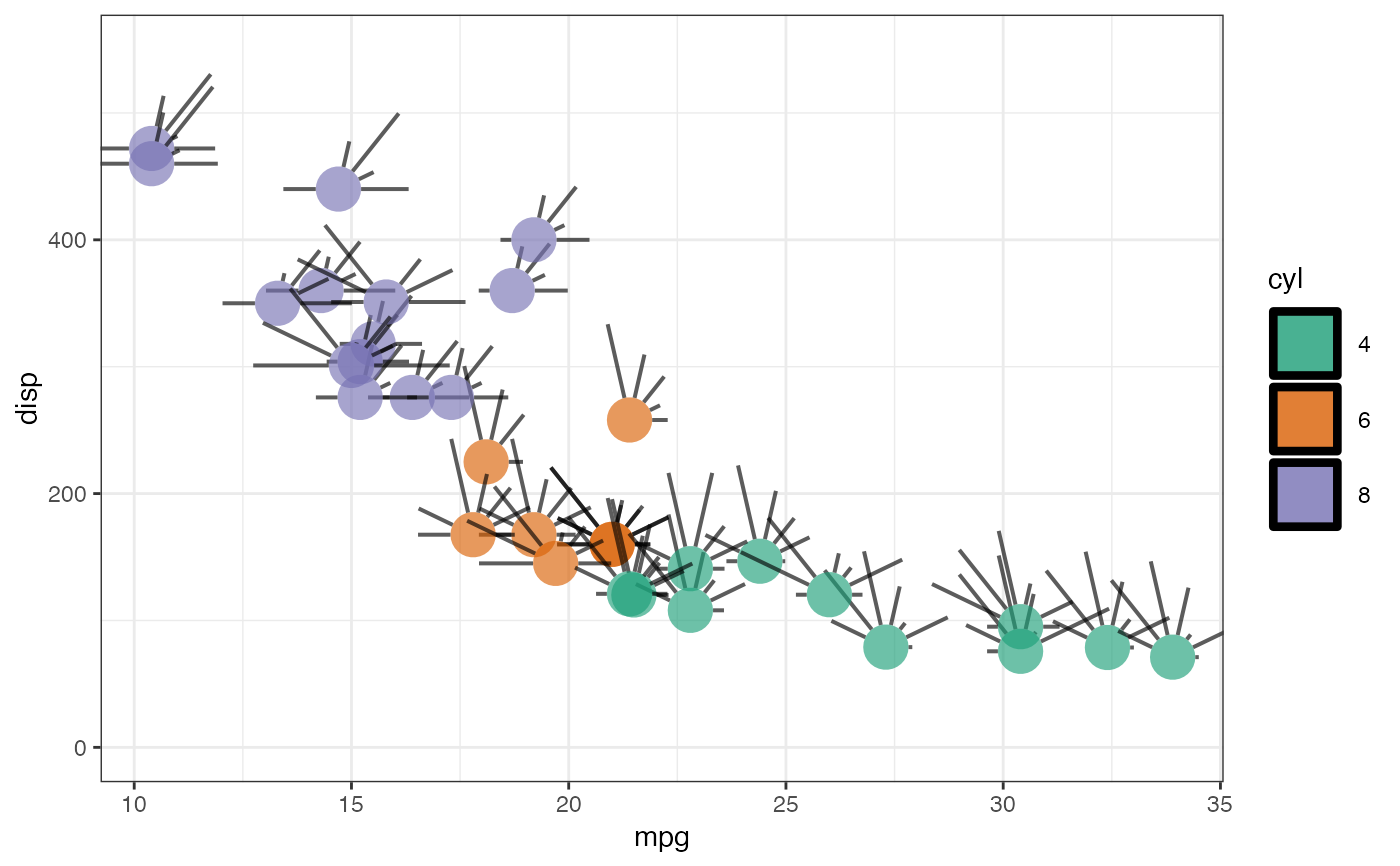 # Rays with colours
ggplot(data = mtcars) +
geom_metroglyph(aes(x = mpg, y = disp),
cols = zs, circle.size = 3,
linewidth.circle = 0, linewidth.ray = 2,
colour.circle = "transparent", fill = "gray",
colour.ray = RColorBrewer::brewer.pal(8, "Dark2"),
size = 10, alpha = 0.8) +
ylim(c(-0, 550))
# Rays with colours
ggplot(data = mtcars) +
geom_metroglyph(aes(x = mpg, y = disp),
cols = zs, circle.size = 3,
linewidth.circle = 0, linewidth.ray = 2,
colour.circle = "transparent", fill = "gray",
colour.ray = RColorBrewer::brewer.pal(8, "Dark2"),
size = 10, alpha = 0.8) +
ylim(c(-0, 550))
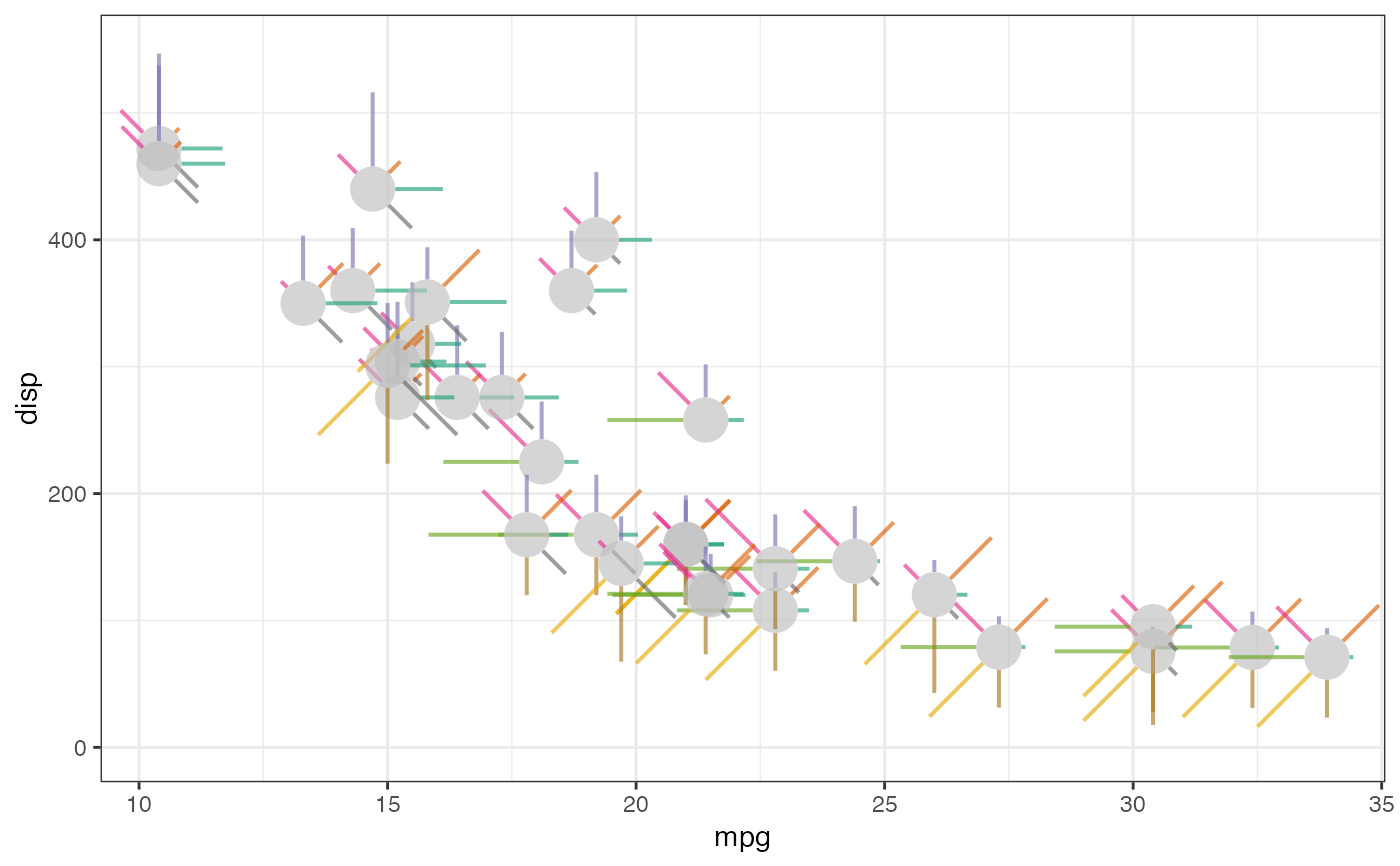 ggplot(data = mtcars) +
geom_metroglyph(aes(x = mpg, y = disp),
cols = zs, circle.size = 3,
linewidth.circle = 0, linewidth.ray = 2,
colour.circle = "transparent", fill = "gray",
colour.ray = RColorBrewer::brewer.pal(8, "Dark2"),
size = 10, alpha = 0.8, full = FALSE) +
ylim(c(-0, 550))
ggplot(data = mtcars) +
geom_metroglyph(aes(x = mpg, y = disp),
cols = zs, circle.size = 3,
linewidth.circle = 0, linewidth.ray = 2,
colour.circle = "transparent", fill = "gray",
colour.ray = RColorBrewer::brewer.pal(8, "Dark2"),
size = 10, alpha = 0.8, full = FALSE) +
ylim(c(-0, 550))
 # Faceted
ggplot(data = mtcars) +
geom_metroglyph(aes(x = mpg, y = disp, colour = cyl),
cols = zs, circle.size = 3, colour.ray = NULL,
linewidth.circle = 2, linewidth.ray = 2,
size = 10, alpha = 0.8) +
ylim(c(-0, 550)) +
facet_grid(. ~ cyl)
# Faceted
ggplot(data = mtcars) +
geom_metroglyph(aes(x = mpg, y = disp, colour = cyl),
cols = zs, circle.size = 3, colour.ray = NULL,
linewidth.circle = 2, linewidth.ray = 2,
size = 10, alpha = 0.8) +
ylim(c(-0, 550)) +
facet_grid(. ~ cyl)
 ggplot(data = mtcars) +
geom_metroglyph(aes(x = mpg, y = disp, fill = cyl),
cols = zs, circle.size = 3, colour.ray = NULL,
linewidth.circle = 2, linewidth.ray = 2,
size = 10, alpha = 0.8) +
ylim(c(-0, 550)) +
facet_grid(. ~ cyl)
ggplot(data = mtcars) +
geom_metroglyph(aes(x = mpg, y = disp, fill = cyl),
cols = zs, circle.size = 3, colour.ray = NULL,
linewidth.circle = 2, linewidth.ray = 2,
size = 10, alpha = 0.8) +
ylim(c(-0, 550)) +
facet_grid(. ~ cyl)
 # Repel glyphs
ggplot(data = mtcars) +
geom_point(aes(x = mpg, y = disp, colour = cyl)) +
geom_metroglyph(aes(x = mpg, y = disp, colour = cyl),
cols = zs, circle.size = 3, colour.ray = NULL,
linewidth.circle = 2, linewidth.ray = 2,
size = 10, alpha = 1, repel = TRUE) +
ylim(c(-0, 550))
#> Warning: 14 glyphs have too many overlaps.
#> Consider increasing "max.overlaps"
# Repel glyphs
ggplot(data = mtcars) +
geom_point(aes(x = mpg, y = disp, colour = cyl)) +
geom_metroglyph(aes(x = mpg, y = disp, colour = cyl),
cols = zs, circle.size = 3, colour.ray = NULL,
linewidth.circle = 2, linewidth.ray = 2,
size = 10, alpha = 1, repel = TRUE) +
ylim(c(-0, 550))
#> Warning: 14 glyphs have too many overlaps.
#> Consider increasing "max.overlaps"
 ggplot(data = mtcars) +
geom_point(aes(x = mpg, y = disp, colour = cyl)) +
geom_metroglyph(aes(x = mpg, y = disp, colour = cyl, fill = cyl),
cols = zs, circle.size = 3, colour.ray = NULL,
linewidth.circle = 2, linewidth.ray = 2,
colour.circle = "transparent",
size = 10, alpha = 1, repel = TRUE) +
ylim(c(-0, 550))
#> Warning: 14 glyphs have too many overlaps.
#> Consider increasing "max.overlaps"
ggplot(data = mtcars) +
geom_point(aes(x = mpg, y = disp, colour = cyl)) +
geom_metroglyph(aes(x = mpg, y = disp, colour = cyl, fill = cyl),
cols = zs, circle.size = 3, colour.ray = NULL,
linewidth.circle = 2, linewidth.ray = 2,
colour.circle = "transparent",
size = 10, alpha = 1, repel = TRUE) +
ylim(c(-0, 550))
#> Warning: 14 glyphs have too many overlaps.
#> Consider increasing "max.overlaps"
 ggplot(data = mtcars) +
geom_point(aes(x = mpg, y = disp)) +
geom_metroglyph(aes(x = mpg, y = disp),
cols = zs, circle.size = 3,
linewidth.circle = 0, linewidth.ray = 2,
colour.circle = "transparent", fill = "gray",
colour.ray = RColorBrewer::brewer.pal(8, "Dark2"),
size = 10, alpha = 1, repel = TRUE) +
ylim(c(-0, 550))
#> Warning: 11 glyphs have too many overlaps.
#> Consider increasing "max.overlaps"
ggplot(data = mtcars) +
geom_point(aes(x = mpg, y = disp)) +
geom_metroglyph(aes(x = mpg, y = disp),
cols = zs, circle.size = 3,
linewidth.circle = 0, linewidth.ray = 2,
colour.circle = "transparent", fill = "gray",
colour.ray = RColorBrewer::brewer.pal(8, "Dark2"),
size = 10, alpha = 1, repel = TRUE) +
ylim(c(-0, 550))
#> Warning: 11 glyphs have too many overlaps.
#> Consider increasing "max.overlaps"
 rm(mtcars)
mtcars[ , zs] <- lapply(mtcars[ , zs], scales::rescale)
mtcars[ , zs] <- lapply(mtcars[, zs],
function(x) cut(x, breaks = 3,
labels = c(1, 2, 3)))
mtcars[ , zs] <- lapply(mtcars[ , zs], as.factor)
mtcars$cyl <- as.factor(mtcars$cyl)
mtcars$lab <- row.names(mtcars)
# Grid points
ggplot(data = mtcars) +
geom_metroglyph(aes(x = mpg, y = disp, colour = cyl),
cols = zs, circle.size = 3, colour.ray = NULL,
linewidth.circle = 2, linewidth.ray = 2,
size = 2.5, alpha = 0.8,
draw.grid = TRUE, grid.point.size = 5) +
ylim(c(-0, 550))
rm(mtcars)
mtcars[ , zs] <- lapply(mtcars[ , zs], scales::rescale)
mtcars[ , zs] <- lapply(mtcars[, zs],
function(x) cut(x, breaks = 3,
labels = c(1, 2, 3)))
mtcars[ , zs] <- lapply(mtcars[ , zs], as.factor)
mtcars$cyl <- as.factor(mtcars$cyl)
mtcars$lab <- row.names(mtcars)
# Grid points
ggplot(data = mtcars) +
geom_metroglyph(aes(x = mpg, y = disp, colour = cyl),
cols = zs, circle.size = 3, colour.ray = NULL,
linewidth.circle = 2, linewidth.ray = 2,
size = 2.5, alpha = 0.8,
draw.grid = TRUE, grid.point.size = 5) +
ylim(c(-0, 550))
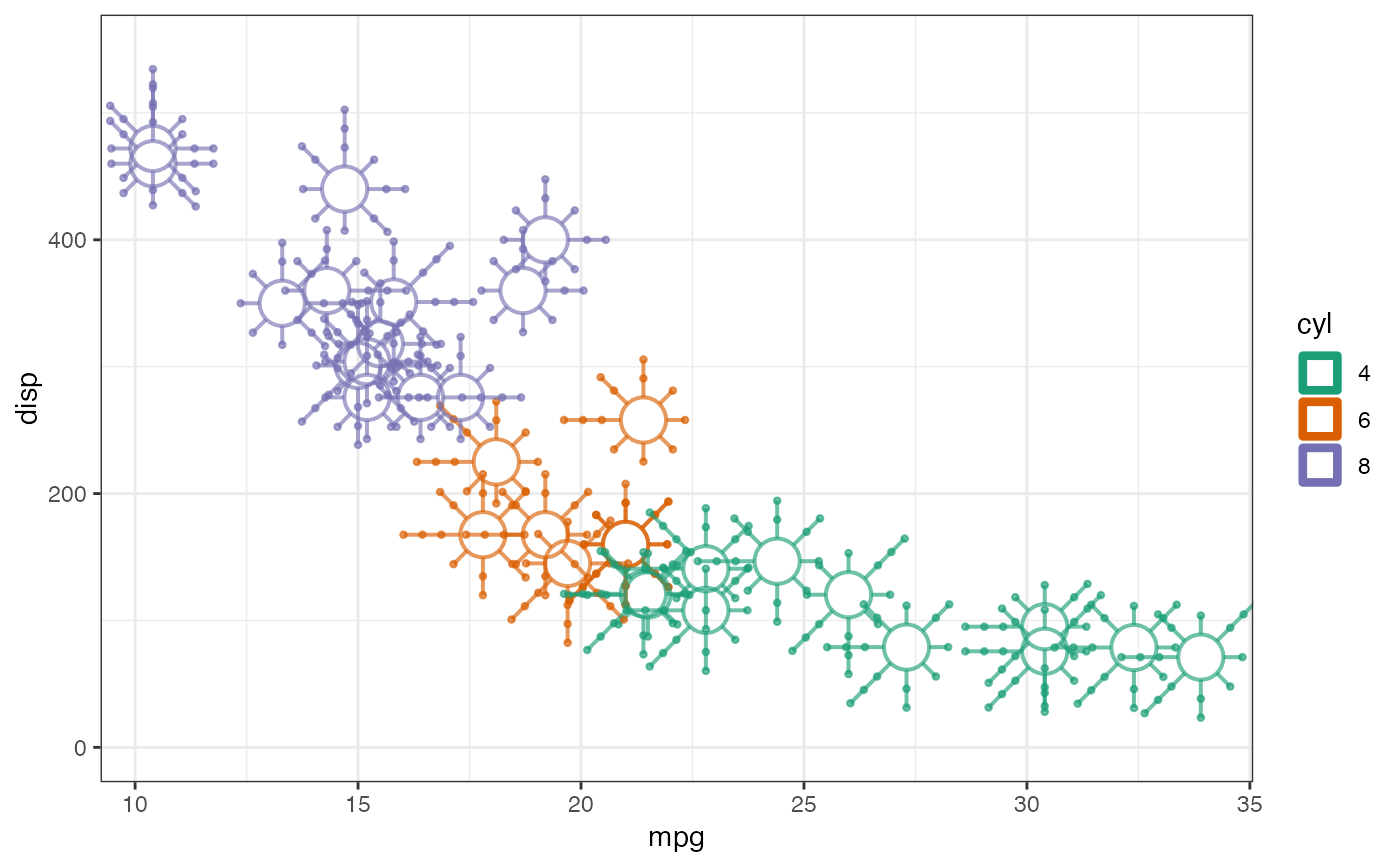 ggplot(data = mtcars) +
geom_metroglyph(aes(x = mpg, y = disp, fill = cyl),
cols = zs, circle.size = 3, colour.ray = NULL,
linewidth.circle = 2, linewidth.ray = 2,
size = 2.5, alpha = 0.8,
draw.grid = TRUE, grid.point.size = 5) +
ylim(c(-0, 550))
ggplot(data = mtcars) +
geom_metroglyph(aes(x = mpg, y = disp, fill = cyl),
cols = zs, circle.size = 3, colour.ray = NULL,
linewidth.circle = 2, linewidth.ray = 2,
size = 2.5, alpha = 0.8,
draw.grid = TRUE, grid.point.size = 5) +
ylim(c(-0, 550))
 ggplot(data = mtcars) +
geom_metroglyph(aes(x = mpg, y = disp),
cols = zs, circle.size = 3,
linewidth.circle = 0, linewidth.ray = 2,
colour.circle = "transparent", fill = "gray",
colour.ray = RColorBrewer::brewer.pal(8, "Dark2"),
size = 2.5, alpha = 0.8,
draw.grid = TRUE, grid.point.size = 5) +
ylim(c(-0, 550))
ggplot(data = mtcars) +
geom_metroglyph(aes(x = mpg, y = disp),
cols = zs, circle.size = 3,
linewidth.circle = 0, linewidth.ray = 2,
colour.circle = "transparent", fill = "gray",
colour.ray = RColorBrewer::brewer.pal(8, "Dark2"),
size = 2.5, alpha = 0.8,
draw.grid = TRUE, grid.point.size = 5) +
ylim(c(-0, 550))
